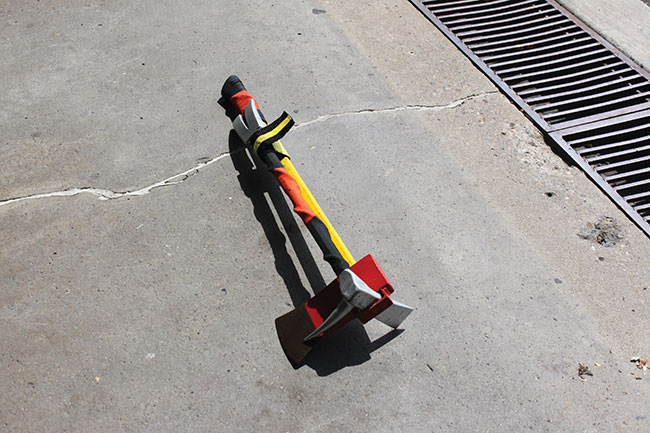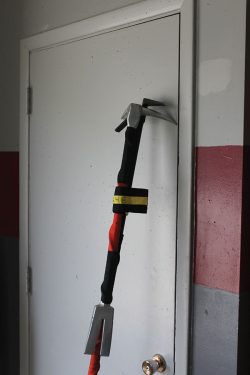
Features
Structural
Training
Back to Basics: Rescue ready
March 11, 2022
By Mark van der Feyst
 Photo 1: The combination of the halligan and the axe can help quicken a rescue Photos: Mark van der Feyst
Photo 1: The combination of the halligan and the axe can help quicken a rescue Photos: Mark van der Feyst The number one fire ground priority is to save lives. All fire departments in North America strive to meet this priority in the interest of the public they serve. Firefighters push themselves to their limits to save the life of a complete stranger. The rescue process begins by being in a readied state for the call of action.
What does it mean to be rescue ready? It refers to a readied state that the firefighter and company officer are in so that they can respond effectively and efficiently to the call and the rescue. There are four key areas that every firefighter and company officer can look at in examination of whether they are rescue ready.
In the station
I have always said that being rescue ready starts right in the station. A good place to look and examine is with the culture of the fire department. Is there a culture within the department both in the upper ranks and lower ranks that lends to being in a readied state? The focus should be on developing rescue plans, establishing or revising SOGs or SOPs on rescue operations, equipping the staff with the best apparatus and equipment, and training personnel on the key points of basic rescue operations as well as how to size up any situation especially for the rescue operation.
Establishing or revising current SOGs or SOPs is also another way to become rescue ready within the station. These documents need to be a living document where they are proven in training and then revised to reflect needed changes. Every firefighter needs to be involved with this process.
Developing rescue plans is also a good avenue to pursue in relation to the SOGs or SOPs that exist on the rescue operation. These defined plans can form part of the guidance or procedure spelled out and will also clearly give direction on what to do based upon the size up.
On the apparatus
Fire apparatus is the second area that can be addressed to become rescue ready. This usually involves setting up hand tools on the apparatus for quick and easy access for any rescue operation. It also involves utilizing compartment space effectively and placing certain tools on the right side of the apparatus.
There is also the aspect of combat ready tools. This is where the fire department can have certain tool combinations pre-made or pre-arranged and then placed in a spot on the apparatus that can be quickly grabbed. Combinations like the halligan and the axe (photo 1) or the haligan and the roof hook (photo 2) are examples of this. There are many different tool variations that can be pre-arranged ahead of time.
Having pre-arranged seating assignments is also a good idea to help quicken the rescue operation. Every seat has a specified job function that is standard, no matter who is sitting in it. This cuts down the time and decision-making ability on who will do what, instead allowing firefighters to react based upon their assigned function.

Photo 2: Combinations like the halligan and the roof hook can be pre-made for ease of use
Training requirements
Training is where we can prove things. We can prove whether certain tactics will work well for certain departments, we can prove who can and who cannot do certain job functions, we can prove skill deficiencies and we can also prove gaps in service levels.
One great way to perform the proving ground is with scenario-based training. By conducting scenarios, it allows for a team approach in tackling a certain problem and opens the doors for creativity in trying to find a solution. It also helps to relate the skills being taught or reinforced to a real-life situation where things may not have gone as planned.
Key skills needed for rescue can also be practiced and maintained so that proficiency and mastery are achieved for every firefighter. It will also help build up the confidence level of each firefighter and strengthen the unity between the team. Training can be a great morale booster.
Size-up information
The last key area that can be examined is with our size-up skills. This is a vast area with different aspects that need to be considered. One area is knowing your response district and the types of residential buildings that comprise it. Knowing the common construction types, the common layouts, the average age of the homes and so on will help with creating different rescue profiles. By having these different profiles, the firefighter and company officer can gauge ahead of time what exactly they are dealing with and when the call comes in, they will have a better understanding of where they are going and what they are getting into.
Another factor that can be added into the equation of knowing the area is with the demographics. Knowing who in terms of average age, type of population – for example, seniors or students — will help with creating a rescue profile. This can be accomplished by searching for this information from local government or from just observing the response district.
Other aspects of the size-up is with knowing common locations of where fire victims are found within the residential structure. They are usually found in exit areas such as windows or doors, on the stairs, and in the hallways, or in their beds depending upon the time of day. Knowing these common locations helps with knowing where to begin the search, which tactic to use and ultimately helps achieve an effective rescue.
Being rescue ready is not just a matter of checking in at the beginning of your shift or just responding to the call. It is a matter of continued and evolving information gathering and preparation that makes one rescue ready.
Mark van der Feyst has been in the fire service since 1999 and is currently a firefighter with the FGFD. He is an international instructor teaching in Canada, the United States, FDIC and India. Contact him at Mark@FireStarTraining.com.
Print this page